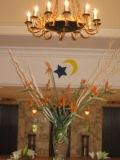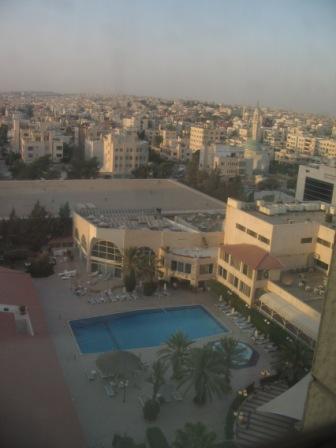On Nov. 24, 2007,
NYIT-Amman students visited
Jerash north of Amman in Jordan.
Jerash, the ancient city of
Gerasa, is an amazing complex of Hellenistic Greek, Roman,
Nabatean, Byzantine and Islamic monuments.
NYIT Art History students were able to see in reality what they study in their textbooks!
Jerash was developed by the Romans after they conquered the Levant in first century BC, although it had been already colonized by the Hellenistic Greek Alexander the Great in 332 BC. Due to its strategic geographic position in
fertile lands with water, high on hills, it became very important. The Greek King
Antiochus IV built a typical Greek city in 2c BC, with a stream dividing the city, however there are traces of Neolithic and earlier settlements on the site.
The Jewish historian Josephus mentions
Jerash, where the treasures of Amman (then called Philadelphia) were safely kept in the Temple of Zeus. The town was later captured by the Jews under the high priest Alexander
Jannaus, from 102- 76 BC. Then the city was captured by the Roman General Pompey in 63 BC. The city functioned independently under Pompey and joined the
league of free cities known as the
Decapolis, most within Jordan. It expanded and was prosperous, trading with Syria and the
Nabataeans from Petra, who influenced the style of stone carving and architecture in the city.
The site represents a typical 1st c. Roman urban planned city, surrounded by stone walls and castles. There are paved streets, all connected by a main street or
Cardo, with elaborate drainage and water systems beneath. The
Cardo is lined with columns of Doric, Ionic and Corinthian capitals. Most of the imperial buildings come from 2
nd c. BC. By the 3rd century
Jerash was at the height of its
prosperity, granted the status of a colony, a free city, and its citizens had rights of Roman citizens, a high standard of living and were exempt from taxation.
By the 4
th century the growth of the Sassanian Kingdom in the east disrupted Rome's trade routes, and was followed by political, economic and religious disputes. Constantine resolved some, and introduced Christianity into the the region as the official religion of the Empire in 324. Many elaborate Byzantine style churches were constructed in
Jerash, especially under Justinian, with elaborate mosaics and ancient pagan temples neglected and often their stones used for the churches.
In 646 Islam spread throughout the region, and
Jerash no longer expanded, but shrunk to about a quarter of its previous size. Small buildings were built among the old structures, including an 8
th century mosque. In the 12
th c. William of Type said
Jerash was then empty, and that the Temple of Artemis had been
converted into a castle to fight the crusaders, however the whole town was captured by Baldwin II, crusader King of Jerusalem 1118-11131.
Jerash was lost, but then discovered by
Seetzen in 1806, and became a settlement for many Jordanian families, especially the
Circassians from Eastern Europe who took refuge there in 1878 during the period of Ottoman suppression.
Jerash still had Roman triumphal arches, a Roman forum, a Hippodrome, Gates, Temples, Theatres, the
Cardo (colonnaded street), a
Nympaeum with fountains, Baths, Churches and Mosques, for us to see.
And,
Jerash has the best BBQ restaurants in Jordan, which is where we ended out trip. Going home was another adventure . . . the bus took a short cut, got lost on the steep, narrow mountain roads between olive plantations, goats, sheep, Bedouin tents, farms, and steep ravines on the side of the road. However, before the sunset, we found the highway, and returned safely to Amman.






